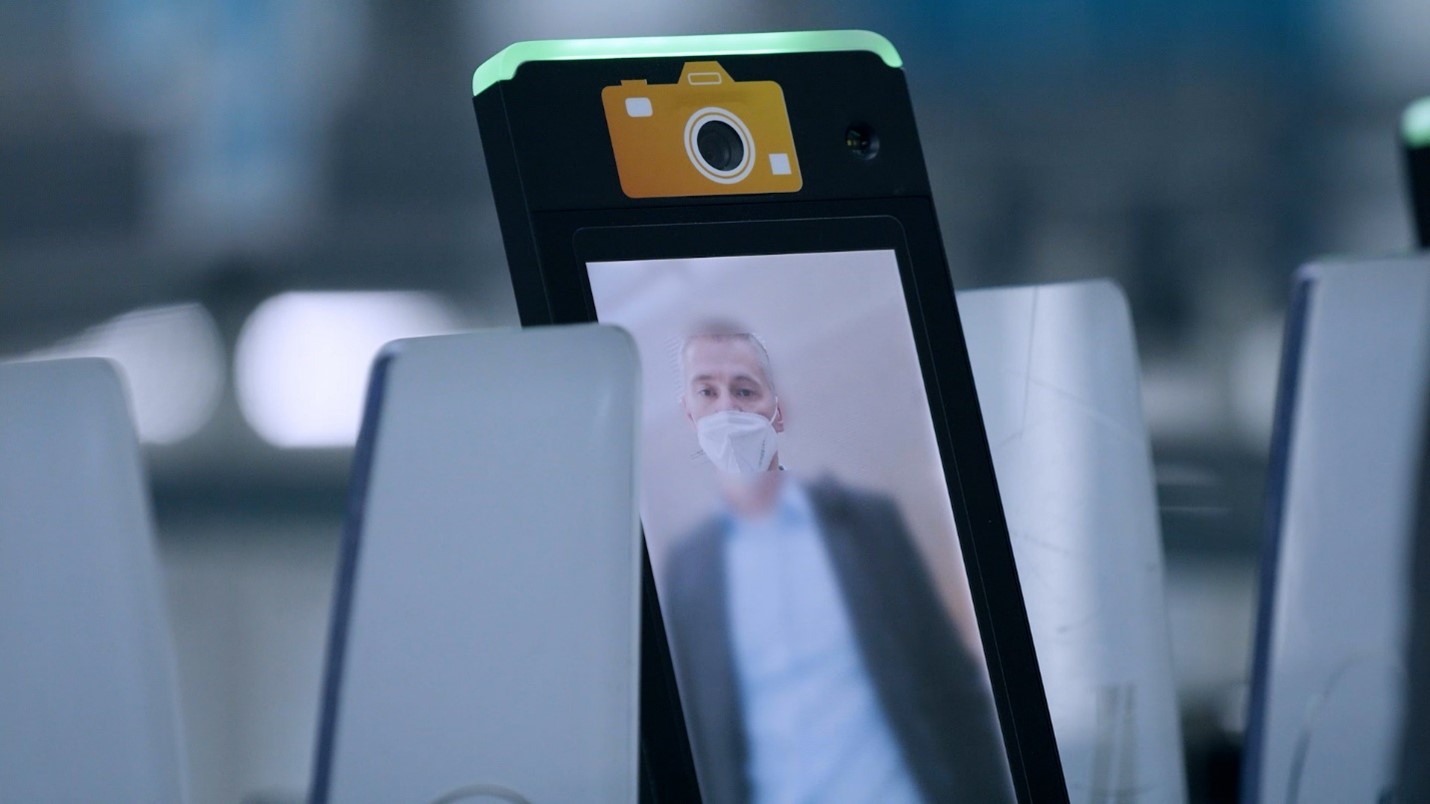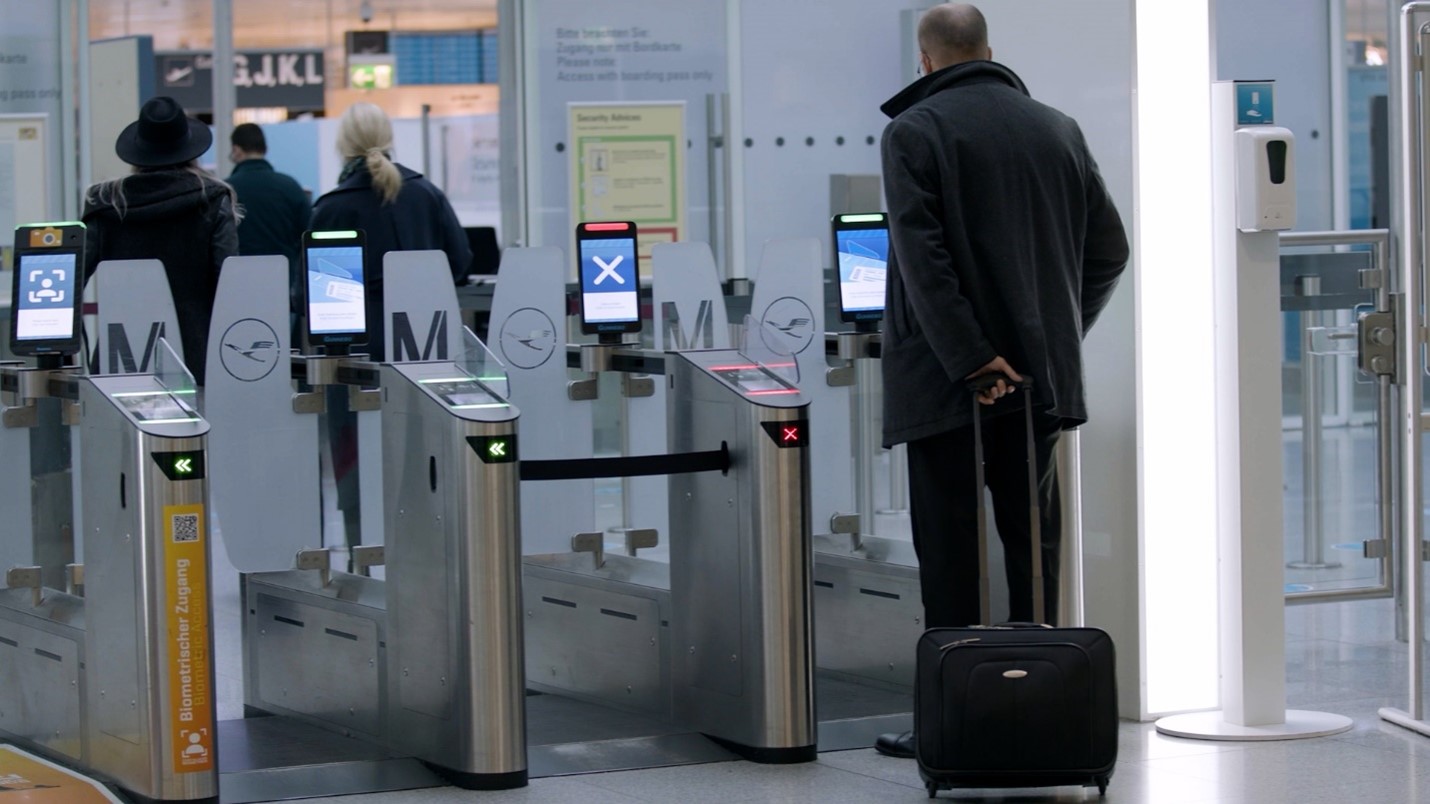Speedy and convenient biometric screening using facial recognition means you no longer have to show your boarding pass at Munich Airport Terminal 2. Simply walk up to the gate, the biometric camera will validate your ID using just your face with secure, touchless technology by Gunnebo.
Munich Airport implements biometric screening for secure ID control
Terminal 2, the modern home of all Lufthansa and Star Alliance flights at Munich Airport, has successfully been using Gunnebo’s Biometric e-Gates since late 2020 when a pilot project with the biometric screening technology was begun. Terminal 2 and Star Alliance see biometric e-gates as a key part of their efforts to improve passenger flows to make them faster, and more user-friendly, and help to meet the projected increase in traveller numbers.
Every passenger who uses biometrics is a happy user,”
says Mr. Tim Dettloff, Manager of Aviation Processes at Munich Airport Terminal 2.
You don’t have to look for your boarding pass in several pockets or wallets to find it. You just use your face and pass the checkpoint.”
The terminal already had Gunnebo’s non-biometric BoardSec gates installed since 2018 but these needed an upgrade to allow fast, accurate, and secure biometric screening using facial recognition for a boarding pass control, Gunnebo was therefore asked to retrofit the existing gates.
Watch the Customer Success Story:
This required upgraded hardware in the form of biometric cameras and user displays, and the necessary exchange of the existing gate PC for an updated high-speed PC. On the software side, a new biometric platform and improved IT connections from the PC were necessary. As a result, front and back-end systems were fully updated and optimized to achieve a seamless passenger experience.
Key challenges of the biometrics project
Privacy, COVID-19, speed of the process, and lighting environment were the four most important challenges that had to be addressed and overcome for the plan to succeed.
No compromising on privacy
Privacy was by far the biggest issue, due to the EU’s strict General Data Protection Regulation (GDPR) which is designed to guarantee individuals' right to protection of their privacy and personal data. Therefore, images had to be taken in a very specific manner and the facial recognition camera could only be running for a short time span when the person to be identified was in the specific target area. In addition, no one else in the departure area should be identified such as other passengers, relatives, airport personnel, etc.
The Gunnebo solution uses integrated biometric sensors that activate only when the person who is registered to be travelling that day approaches the gate in a very specific zone and distance, making it impossible to photograph any unintentional bystanders. The biometric ID user is the only facial recognition image activated and recorded.
Biometric screening must also work with COVID face masks
The Terminal 2 biometric access implementation took place during late 2020, when the extent and longevity of COVID-19 was, and still is uncertain. Thus, the camera in the biometric system needed to be able to work both with and without face masks. Interestingly, the smart software built into the system allows good facial recognition even when the passenger is wearing a mask covering a portion of their face.
For hygiene reasons it also had to be a completely touchless process, with the use of the gate being conducted without requiring one single point of physical contact with the gate and other surfaces. The chosen solution achieved this, eliminating touchpoints while allowing the traveller to walk straight through in a seamless flow, minimising bottlenecks and keeping passengers safe.
Recognition and matching speed of less than 2 seconds
A further upgrade that was needed concerned the system computer speed. If the biometric matching process took more than just a couple of seconds, users might get frustrated and during busy times, the seconds of delay per person would lead to increased queues and wait times. Therefore, the computer was upgraded to an IB917 system computer with the latest generation processor to give the highest image matching speed and avoid lags and possible delays.
Lighting can be an issue, but Munich levels were fine
As with any photographic camera, the lighting conditions are very important to get a good image. And every airport and location is different, meaning lighting must be assessed and augmented if needed. In Munich however, no extra lighting was necessary since it features a large glass roof that allows a lot of natural daylight, and at night the high ceilings have plenty of lights for good illumination.
In April 2022, Gunnebo biometric BoardSec gates also went live in Hamburg Airport. There, however, the lighting conditions were not as bright as in Munich Airport, so additional flashlights next to the camera were used to improve lighting and imagery.
One-time enrolment then can be used at many airports and airlines
For passengers, enrolling is simple – involving only downloading the Star Alliance App, taking a photo of the face and passport, and registering them. From this enrolment, a biometric token is created. Once this is done, the biometric token can be used for any Lufthansa, Swiss or Austrian Airlines flights where biometric e-gates are in use.
The system works by producing a gallery with pictures of travellers scheduled to fly on that date. The gates are thus expecting them and will therefore function with the biometric token generated.
Star Alliance is extremely pleased with the success of its e-gates and has stated that it plans to be using biometric e-gates for 50% of its boarding pass control by 2025.
Mr. Christian Draeger, Star Alliance’s VP of Customer Experience, explains.
Biometrics is really a game-changer in terms of customer experience. This has been highlighted by the pandemic, but even before that, it was clear this technology would bring significant improvements to the customer experience in terms of a seamless flow through the different touchpoints. Biometrics achieves this in a very intuitive manner.”
Topics:
Facial Recognition,
Biometric Screening



